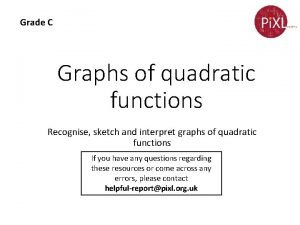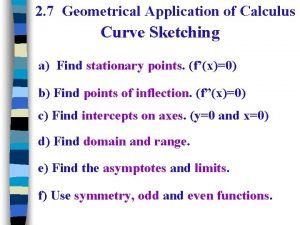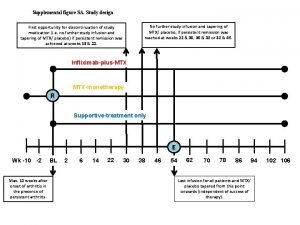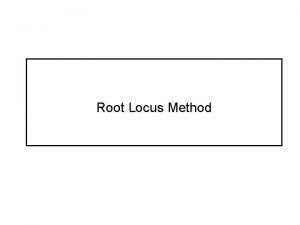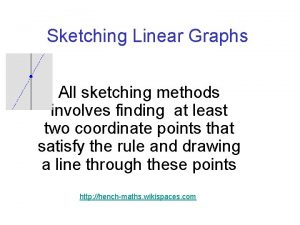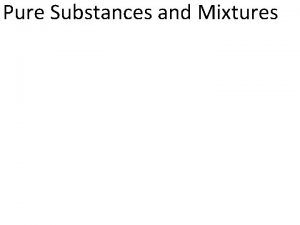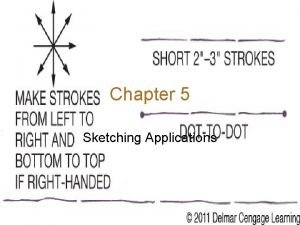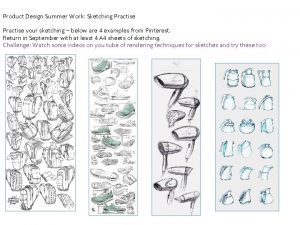Further Pure 1 Lesson 7 Sketching Graphs Graphs



























- Slides: 27

Further Pure 1 Lesson 7 – Sketching Graphs

Graphs and Inequalities Wiltshire n Good diagrams Communicate ideas efficiently. n Helps discovery & understanding of relationships. n Essential Features include n Points where axes are crossed. n Nature and position of turning points. n Behaviour as x or y tend to infinity. n Need to be able to check using a calculator or computer but must be able to do it independently. n

Rational Functions Wiltshire n A rational function is defined as a function N(x)/D(x), where N(x) & D(x) are polynomials. n Note that D(x) = 0 n (This is similar to the notion of a rational number, n/d) n What does the graph of y = 1/x look like? n What happens when x = 0? n Now what would the graph of y = 1/(x-2)+3 look like.

Using Transformations n Now what would the graph of n n n y = 1/(x-2)+3 look like. This will look the same as y = 1/x but after two transformations. The (x – 2) shifts the graph right 2. Then the +3 shifts the graph up 3. Notice where the asymptotes have moved too. This would be the same as y = (3 x – 5)/(x - 2) Wiltshire

Using Transformations n How could we plot the graph y = (2 x+9)/(x+4) y = 1/(x+4)+2 n Or 2 x + 4 2 x + 9 2 x + 8 1 n We can now use transformations to plot the graph. Wiltshire

Questions n Plot the following graphs i) iii) Wiltshire

Vertical Asymptotes n An asymptote is a straight line which a curve n n n n Wiltshire approaches tangentially as x or y tends to infinity. Asymptotes are usually shown on a graph by a dotted line. In the graph y = 1/x there is an asymptote at x = 0. This is because as x gets smaller and smaller y tends to infinity. (Note: it can help that 1/0 is undefined) What would the vertical asymptote be for the graph y = 1/(x – 3)? x = 3. In general the asymptote for y = 1(x - a) will be x = a. and the asymptote for y = 1/(x + a) will be x = -a.

Vertical Asymptotes Wiltshire n What are the vertical asymptotes for the following graphs? i) iii)

Sketching Graphs Wiltshire n We are now going to look at the steps for sketching the graph. n There are some steps to follow to ensure that the graph is plotted correctly. 1) Find where the graph cuts the axes. 2) Find the vertical asymptotes and examine the behaviour near them. 3) Examine the behaviour as x tends to infinity. 4) Complete the sketch

Sketching Graphs Wiltshire n Step 1 - Find where the graph cuts the axes. n The graph will cut the y-axis when x = 0, and the x- axis when y = 0. n So when x = 0 n And when y = 0 n The graph will cut the axes at the co-ordinates (0, 2) and (6, 0).

Sketching Graphs Wiltshire n The graph will cut the axes at the co-ordinates (0, 2) and (6, 0). n We can plot these two co-ordinates on the graph.

Sketching Graphs Wiltshire n Step 2 - Find the vertical asymptotes and examine the behaviour near them. n The vertical limits will be when x = -3 & x = 1

Sketching Graphs Wiltshire n There are 2 vertical asymptotes that can be approached from 2 directions. n We need to look at each of the 4 scenarios.

Sketching Graphs i) Wiltshire When x is slightly less than -3. (x-6) is negative, (x+3) is negative and very small and (x-1) is negative.

Sketching Graphs Wiltshire ii) When x is slightly greater than -3. (x-6) is negative, (x+3) is positive and very small and (x-1) is negative.

Sketching Graphs i) Wiltshire When x is slightly less than 1. (x-6) is negative, (x+3) is positive and (x-1) is a very small negative.

Sketching Graphs i) Wiltshire When x is slightly greater than 1. (x-6) is negative, (x+3) is positive (x-1) is very small positive.

Sketching Graphs Wiltshire n Step 3 - Examine the behaviour as x tends to infinity. n As x tends to infinity y tends to zero from above the x-axis. n As x tends to negative infinity y tends to zero from below the x- axis. n So y = 0 is a horizontal asymptote.

Sketching Graphs n Step 4 – Sketch the graph. Wiltshire

Sketching Graphs Wiltshire Notice that the graph is a smooth curve. There is a local minimum between x = -3 & 1. There is a local maximum just after x = 6. How do we know that there are only two turning points? We can find the exact position of the maxima and minima by solving dy/dx = 0. n However you will not study this until C 3. n n n

Sketching Graphs Wiltshire n An alternative way to look at it would be to consider the graph y n n n equal to horizontal lines c. If y = (x-6)/((x+3)(x-1)) = c Then (x-6)=c(x+3)(x-1) Unless c = 0 then this is a quadratic equation with 3 possible outcomes. i) No solution ii) One solution iii) Two solutions As the quadratic cannot have more than 2 solutions, then the green line is impossible. This proves that our original drawing was correct. Can you explain how this would also show that the local maximum must be lower than the local minimum?

Sketching Graphs n Sketch the following graphs? i) iii) Wiltshire

Complicated example n Sketch the following graph. Wiltshire

Using Symmetry Wiltshire n Efficient knowledge of symmetrical curves can help you when sketching graphs. n If f(x) = f(-x) then f(x) is symmetrical about the y-axis. n Graphs of this type are known as even functions n Note if f(x) = -f(-x) then f(x) has rotational symmetry of order 2 about the origin. n Graphs of this type are known as odd functions. n Name an even and an odd function.

Using Symmetry Wiltshire n Sketch the graph n Step 1 – n Step 2 – n Step 3 – n Step 4 – When x = 0, y = 5 When y = 0 there is no x There is no x that makes x 2+3 = 0 therefore no vertical asymptotes exist. As x tends to +ve/-ve infinity y tends to 2. So y = 2 is a horizontal asymptote. As x only contains even powers of x, y is an even function, and so is symmetrical about the y-axis.

Using Symmetry Wiltshire

Using a Graphics Calculator Wiltshire
 Dr frost sketching quadratics
Dr frost sketching quadratics Sketching graphs of quadratic functions
Sketching graphs of quadratic functions Sketching reciprocal graphs
Sketching reciprocal graphs Sketching graphs calculus
Sketching graphs calculus Testability tips in software testing
Testability tips in software testing Comparing distance/time graphs to speed/time graphs
Comparing distance/time graphs to speed/time graphs Graphs that enlighten and graphs that deceive
Graphs that enlighten and graphs that deceive 5-3 practice polynomial functions
5-3 practice polynomial functions Baseline crime scene sketch
Baseline crime scene sketch Cohesion
Cohesion Further study design
Further study design Sketching vocabulary
Sketching vocabulary Sketching the crime scene
Sketching the crime scene What is root locus in control system
What is root locus in control system Strong iron post on a ship deck for working fastening lines
Strong iron post on a ship deck for working fastening lines The common views used in multi-view drawing
The common views used in multi-view drawing Add the missing lines
Add the missing lines Dr frost further kinematics
Dr frost further kinematics Pictorial view engineering drawing
Pictorial view engineering drawing Springs and strings
Springs and strings Cross-projection sketch
Cross-projection sketch Not for further distribution
Not for further distribution Sketch chapter 7
Sketch chapter 7 This is to certify further
This is to certify further Further applications of integration
Further applications of integration Further applications of integration
Further applications of integration Time series further maths
Time series further maths Cross-projection sketch
Cross-projection sketch

